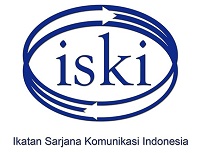Firehose of Falsehood Propaganda Model in the 2019 Indonesian Presidential Election
Abstract
The general election is a democratic means to gain power constitutionally. Several groups, however, use all the possible means to achieve that power. Firehose of falsehood is an example of political propaganda models that use every means to influence public opinion. This model of political propaganda finds its momentum through propaganda on social media. The purpose of this research is to understand the model of the firehose of falsehood on social media in the 2019 Indonesian presidential election. This research method uses a discourse analysis approach to identify the phenomena and events regarding the use of political propaganda on social media. Meanwhile, data collection is carried out through Twitter social media documentation. The results of this analysis indicated that the Firehose of Falsehood propaganda model was used as a political propaganda in the 2019 Indonesian presidential election. Social media, especially Twitter, became a means of propaganda to influence public opinion. The message delivery models were carried out through several methods. First, they were disseminated massively through various channels; second, they were carried out continuously and repeatedly; third, they were not following objective facts; and fourth, the media were lack of consistency.
Keywords
Full Text:
PDFReferences
Allcott, H., & Gentzkow, M. (2017). Social media and fake news in the 2016 election. In Journal of Economic Perspectives (Vol. 31, Issue 2, pp. 211–236). American Economic Association. https://doi.org/10.1257/jep.31.2.211
Asa, A. L., Herani, I., Asqori Pohan, I., & Afif Alhad, M. (2020). Kekacauan Pemilu 2019: Fenomena Firehose of falsehood dalam Relasi Sikap terhadap HOAX dan Kepercayaan Masyarakat Terhadap Komisi Pemilihan Umum. Jurnal Transformative, 6(1), 1–27. https://doi.org/10.21776/ub.transformative.2020.006.01.1
Bakshy, E., Messing, S., & Adamic, L. A. (2015). Exposure to ideologically diverse news and opinion on Facebook. Science, 348(6239), 1130–1132. https://doi.org/10.1126/science.aaa1160
Baxter, R., Hastings, N., Law, A., & Glass, E. J. . (2008). Gaya Hidup. Animal Genetics, 39(5), 561–563. https://doi.org/10.1007/s00702-018-1900-6
Bennett, W. L., & Segerberg, A. (2013). The logic of connective action: Digital media and the personalization of contentious politics. Cambridge University Press.
Berinsky, A. J. (2017). Rumors and Health Care Reform: Experiments in Political Misinformation. British Journal of Political Science, 47(2), 241–262. https://doi.org/10.1017/S0007123415000186
Chadwick, A. (2013). The hybrid media system: Politics and power. Oxford University Press.
CNNindonesia. (2018). Rangkap Jabatan dan Inkonsistensi Jokowi Jelang Pilpres 2019. Cnn.Com. https://www.cnnindonesia.com/nasional/20180121131347-32-270502/rangkap-jabatan-dan-inkonsistensi-jokowi-jelang-pilpres-2019
Creswell, J. W. (2009). Research Design Qualitative, Quantitative, and Mixed Methods Approaches Third (Third). SAGE Publications.
Cutlip, S. M., Center, A. H., & M, B. G. (2006). Effective Public Relations (9th ed.). Prenadamedia Group.
Detikcom. (2019). Inkonsistensi Klaim Kemenangan Prabowo. Detik.Com. https://news.detik.com/berita/d-4584171/inkonsistensi-klaim-kemenangan-prabowo
DiFonzo, N. & Bordia, P. (2007). Rumor psychology: Social and organizational approaches. American Psychological Association. https://doi.org/10.1037/11503-000
Drone Emprit Academic. (2019). Fake News, Electronic information and Transaction Law, and Civil Society Initiatives in Indonesia. Drone Emprit Academic. https://www.slideshare.net/IsmailFahmi3/fake-news-electronic-information-and-transaction-law-and-civil-society-initiatives-in-indonesia
Fardiah, D., Darmawan, F., Rinawati, R., Abdul, R., & Lucky, K. (2020). Media Literacy for Dissemination Anticipated Fake News on Social Media. Mediator: Jurnal Komunikasi, 13(2), 278–289.
Flanagin, A. J., & Metzger, M. J. (2013). Trusting expert versus user-generated ratings online: The role of information volume, valence, and consumer characteristics. Computers in Human Behavior, 29(4), 1626–1634. https://doi.org/10.1016/j.chb.2013.02.001
Golose, P. R. (2019). Strategi Penanganan Firehose of Falsehood pada Era Post-Truth. Jurnal Ilmu Kepolisian, 13(April).
Haqqi, A. (2020). Propaganda Firehose of Falsehood Pada Pemilu 2019 Di Indonesia. WACANA: Jurnal Ilmiah Ilmu Komunikasi, 19(2), 175–185. https://doi.org/10.32509/.v19i2.1058
Harkins, S. G., & Petty, R. E. (1987). Information Utility and the Multiple Source Effect. Journal of Personality and Social Psychology, 52(2), 260–268. https://doi.org/10.1037/0022-3514.52.2.260
Haryatmoko. (2019). Critical Discourse Analysis: Landasan Teori, Metodologi dan Penerapan. Raja Grafindo Persada.
Jowett, G. S., & O’Donnell, V. (2015). Propaganda & Persuasion (7th Edition (ed.)). Sage Publication.
Katadata. (2016). Jokowi Undang 10 Juta Turis Cina, Bukan Pekerja. Katadata.Co.Id. https://katadata.co.id/arnold/berita/5e9a56c2adbf9/jokowi-undang-10-juta-turis-cina-bukan-pekerja
Kuncoro, A. S. (2022). Critical Discourse Analysis of Rejecting the Andesite Mining in Wadas Village News on Tempo.co. Mediator: Jurnal Komunikasi, 15(1), 28–40.
Lasswell, H. D. (1927). The Theory of Political Propaganda. American Political Science Review, 21(3), 627–631. https://doi.org/10.2307/1945515
Lilleker, D. G., Koc-michalska, K., Lilleker, D. G., & Koc-michalska, K. (2016). What Drives Political Participation ? Motivations and Mobilization in a Digital Age What Drives Political Participation ? Motivations and Mobilization in a Digital Age. Political Communication, 34(1), 1–23. https://doi.org/10.1080/10584609.2016.1225235
Mastel. (2019). Hasil Survey Wabah Hoax Nasional 2019. Website Masyarakat Telematika Indonesia, 35. https://mastel.id/hasil-survey-wabah-hoax-nasional-2019/
Merdeka.com. (2016). Banyak WN China seliweran di Kukar diduga tenaga kerja ilegal. Merdekan.Com. https://www.merdeka.com/peristiwa/banyak-wn-china-seliweran-di-kukar-diduga-tenaga-kerja-ilegal.html
Neuman, W. R., Guggenheim, L., Jang, M. S., &, & Bae, S. Y. (2014). The Dynamics of Public Attention: Agenda-Setting Theory Meets Big Data. Journal of Communication, 64(2), 193–214. https://doi.org/10.1111/jcom.12088
Paul, C., & Matthews, M. (2017). The Russian “Firehose of Falsehood” Propaganda Model: Why It Might Work and Options to Counter It. The Russian “Firehose of Falsehood” Propaganda Model: Why It Might Work and Options to Counter It. https://doi.org/10.7249/pe198
Quan-Haase, A. (2013). “Internet”, Encyclopedia of Media and Communication. University of Toronto Press.
Reich, T., & Tormala, Z. L. (2013). When contradictions foster persuasion: An attributional perspective. Journal of Experimental Social Psychology, 49(3), 426–439. https://doi.org/10.1016/j.jesp.2013.01.004
Rucker, D. D., Petty, R. E., & Briñol, P. (2008). What’s in a frame anyway?: A meta-cognitive analysis of the impact of one versus two sided message framing on attitude certainty. Journal of Consumer Psychology, 18(2), 137–149. https://doi.org/10.1016/j.jcps.2008.01.008
Sapitri, H., & Nurafifah, N. L. (2020). Media Televisi Swasta Dan Politik Dalam Pemilihan Presiden 2019 Ditinjau Dari Perspektif Agenda Setting Private Television Media and Political in Presindential Election 2019 From the Agenda Setting of Perspektive. Jurnal Penelitian Komunikasi Dan Opini Publik, 24(2), 113–122.
Setkab.go.id. (2016). Soal Kedatangan 10 Juta Warga Tiongkok, Presiden Jokowi: Itu Turis, Bukan Pekerja. Setkab.Go.Id. https://setkab.go.id/soal-kedatangan-10-juta-warga-tiongkok-presiden-jokowi-itu-turis-bukan-pekerja/
Stier, S., Bleier, A., Lietz, H., & Strohmaier, M. (2018). Election Campaigning on Social Media: Politicians, Audiences, and the Mediation of Political Communication on Facebook and Twitter. Political Communication, 35(1), 50–74. https://doi.org/10.1080/10584609.2017.1334728
Tahir, R., Kusmanto, H., & Amin, M. (2020). Propaganda Politik Hoaks dalam Pemilihan Presiden Tahun 2019. Perspektif, 9(2), 236–251. https://doi.org/10.31289/perspektif.v9i2.3458
Thorson, K., & Wells, C. (2016). Curated Flows: A Framework for Mapping Media Exposure in the Digital Age. Communication Theory, 26(3), 309–328. https://doi.org/10.1111/comt.12087
Umar, M. (2005). Propaganda Feminisme dan Perubahan Sosial. Mediator: Jurnal Komunikasi, 6(2), 205–214.
Vaccari, C. (2017). Online Mobilization in Comparative Perspective: Digital Appeals and Political Engagement in Germany, Italy, and the United Kingdom. Political Communication, 34(1), 69–88. https://doi.org/10.1080/10584609.2016.1201558
Ziegler, R., Diehl, M., Zigon, R., & Fett, T. (2004). Source Consistency, Distinctiveness, and Consensus: The Three Dimensions of the Kelley ANOVA Model in Persuasion. Personality and Social Psychology Bulletin, 30(3), 352–364. https://doi.org/10.1177/0146167203261297
DOI: https://doi.org/10.29313/mediator.v15i2.10573
Refbacks
- There are currently no refbacks.

This work is licensed under a Creative Commons Attribution 4.0 International License























